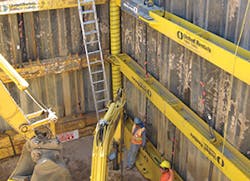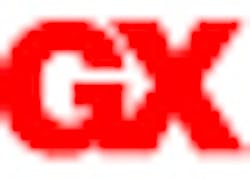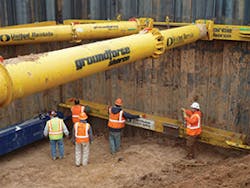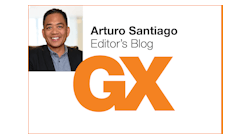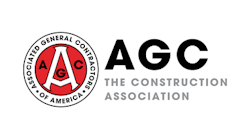For contractors such as Mike Anderzack, president of Anderzack-Pitzen Construction, there is nothing more important on a job site than safety.
Located in northwestern Ohio, Anderzack-Pitzen Construction’s jobs are primarily focused on water and sewer pipe installation as well as road construction. When work goes underground, proper trenching and shoring must go with it, Anderzack points out.
“If you hurt or kill someone, you’re out of business or you’re not going to be very successful,” he says. “Our number-one goal is to make sure our people are safe.”
A concern that consumes the most amount of time for grading and excavation contractors is coming up with efficient methods to handle crossing utilities as well as the more confined work areas, says Mike Ross, national training director for Efficiency Production. “We are running out of wide open spaces to lay pipe,” he says. “We are dealing more with size and site restrictions and crossing utilities.”
Ron Wey, vice president of Pro-Tec Equipment, points out there always are concerns when digging in the ground.
When it comes to effective shoring, it’s good to get expert advice.
“You’re never 100% sure what’s there, so there’s always a big concern about digging up utility lines, which can be dangerous,” he says. “You can dig up a gas line or a water line. Even when they’ve got trenching shields on the job and they have prepared themselves, they oftentimes dig up a utility line, which makes it a challenge on how to shore around those cross utilities. There’s a big concern about OSHA and contractors making sure they’re in compliance with all of the local, state and federal regulations.”
Essentially, most contractors want to do the job correctly, says Wey.
“They want to do it the safe way and they want to meet the various regulations, but they dig up something they weren’t anticipating and that makes it a challenge to figure out what the next step might be,” he says.
By definition, not all trenches and excavations need to be shored or incorporate shielding, points out Keith Lamberson, president of Trench Shoring Services.
“OSHA defines an excavation as any man-made cut, cavity, trench, or depression in an earth’s surface, formed by earth removal,” he says. “OSHA’s definition of a trench is a narrow excavation-in relation to its length-that’s made below the surface of the ground. In general, the depth is greater than the width, but the width of the trench measured at the bottom is not greater than 15 feet-an excavation is also considered to be a trench.”
Lamberson adds that OSHA’s definition of shoring is “a structure such as a metal hydraulic, mechanical, or timber shoring system that supports the sides of an excavation and which is designed to prevent cave-ins…a shield as a structure that is able to withstand the forces imposed on it by a cave-in and thereby protect employees within the structure.”
The relationship between them lies in what is going to be done with the excavation or trench, says Lamberson.
“Are we installing pipe? Are we excavating for foundations? Are we installing a cut-off wall? When the outcome is determined, only then can the decision to use shoring or shielding be made,” he adds.
Proper planning is always beneficial in determining the proper methodology, the meeting of OSHA requirements, and ultimately finding the most cost-effective shoring solutions, says Lamberson.
Regarding how much interaction there should be between the trenching and shoring activities, ideally there should be open communication between the selected shoring supplier before and during the trench work-not only to optimize safety, but also to maintain an efficient work flow for the contractor, says Brett Sondergard, trench safety sales and marketing director for United Rentals.
“Any number of factors can influence the type of shoring solution we recommend, and they relate to the excavating as well, such as soil conditions, adjacent structures, underground utilities, trench dimensions and vibration issues,” he says.
The benefit to using a single-source rental company is that the project is not approached piecemeal, Sondergard says.
“A lot of interaction takes place between our trench safety team and our construction equipment team to make sure the contractor is at an advantage,” he adds.
Production is the initial and main purpose for trenching and shoring systems, Ross points out.
“You make the smallest excavation and create the least amount of damage with the least amount of backfill and restore the smallest area possible, which means more profit because you’re getting paid by the foot,” says Ross. “The least amount of money you spend per foot means more profit at the end.”
Efficient production equals safe production, he adds.
“By being efficient by keeping the dirt out so you don’t have to handle it twice, you’re also by default being safe because there is no dirt coming in to get you,” he adds.
“OSHA requires incorporating shoring into the trenching plan,” notes Anderzack, whose company uses Pro-Tec Equipment. “The use of shoring speeds the operation up from the standpoint of cave-ins, and if we’re in a premium backfill situation, shoring can save on the use of premium backfill.”
The top three products used in trenching activities by those who use Pro-Tec Equipment are steel trench shields, aluminum trench shields, and a slide rail system, notes Ron Wey.
Pro-Tec Equipment ProSeries line of double-wall trench shields are manufactured in 4-, 6- and 8-inch double-wall sidewalls to match machine capacity and depth requirements. The trench shields feature a four-point lifting system, a choice of knife edge or no knife edge, and a full-length double-tube top rail to provide built-in I-beam strength.
The company’s aluminum trench shields are prefabricated to standard or custom sizes using lightweight, foam-filled panels and are typically used by municipalities and utility contractors needing to increase excavation safety. A telescoping spreader sets for varying trench widths. The foam filling is designed to prevent dirt and water buildup. An extra lightweight design is used for tractor loader and backhoe handling.
Pro-Tec Equipment’s slide rail shoring system is designed as an economical alternative to conventional tight-sheeting methods for use in poor soil condition and where soil support is required.
The dig-and-push system allows low-vibration installations and provides soil support for excavations, adjacent structures and existing utilities.
The system, modular and flexible, is designed for quick installation and removal by a small crew. It is installed from the top down and removed from the bottom up to minimize the size of excavation, soil disturbances, and restoration time and cost.
Wey says the products are of value in trenching jobs deeper than 5 feet.
“At 5 feet or deeper, you have OSHA requirements either to slope back by cutting extra dirt away or “˜V-ing’ out your trench,” he says. “Oftentimes, you’re not able to do that because of roads, sidewalks, driveways, and buildings, and you’re not able to slope back the trench. You have to put some type of a shielding or a shoring-type product in the ditch, which would keep the dirt from caving in and undercutting any kind of sidewalk or road house, but it also protects the workers from cave-ins because workers still get hurt and there are still fatalities every year from cave-ins.”
Efficiency Production manufactures such underground production, shoring, and safety equipment as trench boxes, steel trench shields, manhole shields, aluminum and modular shields, slide-rail systems, hydraulic shoring, and Stone Mizers bedding material containers.
The company’s slide-rail system is the latest technology for underground work, says Ross. The slide rail is a component system comprised of steel panels and posts used as a cost-effective alternative to traditional driven close-sheeting. The universal system is designed to be used in a variety of configurations to meet shoring challenges such as poor soil conditions or near adjacent structures.
As the trench or pit is excavated, the slide rail is installed simultaneously by sliding the panels into rails on the posts and then pushing the panels and posts down incrementally to grade as the pit is dug in a dig-and-push system. Efficiency Production’s slide-rail posts have a double or triple rail that telescopes panels to required depth.
There can be cost benefits in incorporating shoring needs into the trenching plan, industry observers say.
It makes a lot of sense to engage the trench safety supplier early in the planning process, says Sondergard. “In many cases, we’re able to provide a safe and competitive design plan as early as the bid stage, based on a cost-benefit analysis.”
The engineering department at United Rentals assists sales representatives with design plans.
“This can help a contractor win the business because it demonstrates a better-than-average focus on safety, planning, and innovative thinking,” says Sondergard. “Large projects may require a combination of protective systems, which is something that needs to be specified and arranged in advance.”
Even with smaller jobs, it’s more productive to work with the supplier to narrow the range of trench protection options before an excavation gets under way, he adds.
Some in the industry say “just in time” approaches may be appropriate to the trenching and shoring process, although site safety considerations may preclude it.
“Site safety conditions obviously trump every other consideration, but in general it’s best to plan in advance and stay ahead of the game,” says Sondergard. “That being said, all kinds of challenges can arise unexpectedly. The shoring supplier needs to have the experts and inventory available to respond “˜just in time’.”
A contractor should never “plow ahead using the initial protective system” if there’s a shift in the nature of the work environment, such as a noticeable change in soil stability, Sondergard says.
In that case, it’s best to stop, call the supplier to the site to review the changes with the engineers, and evaluate the new circumstances, he adds.
Lamberson says rather than “˜just in time,’ a better methodology is that of preplanning the work, the digging, and the shoring.
“This is essential even though there are unforeseen circumstances such as unmarked utilities and ever changing job-site conditions,” he says. “By preplanning, it helps eliminate decision-making error, and it clearly defines decision-making responsibility and decision-making liability. This leads to lower overall cost of compliance.”
Wey agrees, adding that he sees more companies trying to anticipate needs.
“The bigger projects are writing that into their plan, but still oftentimes the contractors don’t know for sure what they need until they are actually on the job and they begin,” he says.
“So there is that element of “˜If we wanted it tomorrow, we would have called you tomorrow.’ Oftentimes, they call for that just-in-time product, so we try to adapt in our production schedule and, also, if we are renting product, to make sure that we have product available.”
The production process itself precludes a just-in-time way of thinking, says Ross.
“For efficient production, one needs to address the problems before they get to them and have a way out if it’s not what they think it is,” he says. “Working underground is unique over most other forms of construction in that you don’t know what the obstacles are until you find them.
“You don’t know what’s in the ground until you’ve dug it up, and you don’t know what the soil conditions are-or in many cases, you don’t know the actual inverts or the actual elevations of things-until after you find them.”
That precludes the wait-until-you-get-to-it mindset, necessitating preparation, Ross says. “You have to have a plan and a backup plan, because, more often than not, what you find is not what you are looking for.”
Anderzack says his company sets up the shoring system well in advance of being on the job site.
“We have quite a few Pro-Tec Equipment shoring systems or boxes, and a lot of consideration goes into shoring before we step foot on the project,” he says.
Rental companies often will send in experts to help manage installations and train the contractors’ employees.
Shoring system providers do provide training in the systems they handle, as well as training in proper installations, Lamberson says.
“However, the shoring companies must be cautious about being inserted into a role otherwise designated by OSHA to be the responsibility of the contractor,” he says. “The contractor must have a competent person onsite. OSHA defines a competent person as a person who is capable of identifying existing and predictable hazards in their surroundings or working conditions that are unsanitary, hazardous, or dangerous to employees. The competent person must have authorization to take prompt corrective measurements to eliminate them.”
On some systems, Pro-Tec Equipment will send in experts to help manage a project.”With the more sophisticated systems like the slide-rail system, we would typically have an onsite consultant work with the contractor for the first day or two to make sure they understand the process of installation,” says Wey. “Oftentimes, we remove that system.”
For projects using the aluminum or steel trench boxes, contractors who’ve been in business for a long time are often familiar using them; in other cases, the company trains dealers who in turn train the contractors.
In dealing with the Efficiency Production slide-rail system, every slide-rail rental comes with a factory-trained and factory-certified installation shoring specialist to guide the contractor or the customer in the proper installation and use of the product, says Ross.
“We’ve worked with Pro-Tec on quite a few specialty projects where they’ve designed shoring systems to meet our needs,” says Anderzack, adding that while his company handles installation and training in-house on all products except for the slide-rail system.
“We usually have one of their techs onsite,” he says. “We don’t use it every day of the week, so they usually send somebody out to make sure it’s done properly.”
United Rentals Trench Safety has product installers on staff, professionally trained and with hands-on field experience, who deploy to job sites to assist customers with the installations, says Sondergard.
The company holds regularly scheduled classroom sessions at its branches in the US and Canada and offers online training courses. The company will assist contractors’ crews that need confined space entry (CSE) training, excavation safety training for competent persons (CPT), or OSHA 10 or 30.
One product on the market offers another layer of safety protection to the trenching and shoring process. Safety Wrap is a reusable polyurethane material used to wrap around and protect the exposed pipe and prevent its scarring. Its color is designed to help operators see the edges.
Joe Schippers, president of Safety Wrap, says his company is affiliated with Two Rivers Pipeline Construction, and as such he’s become well aware of what can happen when something goes wrong on the job.
“We’re well-prepared ahead of time on what we’re going to need for our trenching and shoring,” he says. “We have that down before you put a tractor on the ground and start cutting dirt.”
There are numerous people moving about on a pipeline construction project, Schippers points out.
“We want to educate our employees that they should not step into anything because with the pipeline industry, you have so many people coming and going,” he says. “You don’t step into a trench unless there is some support there.”
Safety Wrap will send people to help train contractors in correct installation procedures. That protects both the contractor as well as Safety Wrap from a liability standpoint, Schippers says.
“If something does happen and somebody says they were unsure how to install it, we can always say we trained somebody here to show everybody how to install it,” he says. “We only have certain people in our establishment who travel around the United States and do the shoring and the trench boxes. That way we don’t have somebody who is inexperienced doing that for us. It’s a certain group of guys who remind me of “˜special forces’. All they do is trenching and shoring and installing Safety Wrap.”